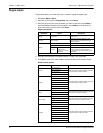
74 © 2014 Schneider Electric All Rights Reserved
Chapter 10—Verifying accuracy PowerLogic™ PM5100 series user guide
6. Depending on the method selected for counting the energy pulses, configure the
meter’s alarm / energy LED or one of the digital outputs to perform energy pulsing.
Set the meter’s energy pulse constant so it is in sync with the reference test
equipment.
7. Perform accuracy verification on the test points. Run each test point for at least 30
seconds to allow the test bench equipment to read an adequate number of pulses.
Allow 10 seconds of dwell time between test points.
Calculating the number of required pulses
The reference test equipment typically requires you to specify the number of pulses
required for a test duration of “t” seconds.
Use the following formula to calculate the required number of pulses:
Where:
• Ptot = total instantaneous power in kilowatts (kW)
• K = the meter’s pulse constant setting, in pulses per kWh
• t = test duration, in seconds (typically greater than 30 seconds)
Calculating total power
The test voltage and current source supplies the same test signals to both the energy
reference/standard and the meter under test. Total power is calculated as follows:
For a balanced 3-phase Wye system:
NOTE: A balanced 3-phase system assumes the voltage, current and power factor
values are the same for all phases.
For a single-phase system:
Where:
• Ptot = total instantaneous power in kilowatts (kW)
• VLN = test point line-to-neutral voltage in volts [V]
• I = test point current in amps [A]
• PF = power factor
The result of the calculation is rounded up to the nearest integer.
Percent error calculation
For every test point:
Number of pulses Ptot K
t
3600
------------
=
Ptot 3 VLN I PF
1 kW
1000 W
-------------------
=
Ptot VLN I PF
1 kW
1000 W
-------------------
=
Energy Error
EM ES–
ES
----------------------
100 %=


















